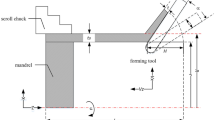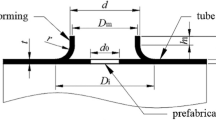Abstract
Sequential knurling and cutting-bending method is proposed to manufacture leaf-like integral outside finned tubes (LIOFT). The numerical analysis method was used to explore the material fracture and plastic forming processes. Single-factor experiments were used to establish quantitative relationships between process parameters and forming quality to guide the design of experimental parameters. The results of the numerical analysis revealed that the teeth of the knurled tube were cut by the tool’s main cutting edge and then slide-bent along the rake face and minor cutting edge during the forming process. The knurling direction significantly affects the fin height and shift, a reasonable knurling direction increases the fin height by 40.1% while reducing the fin shift by 94.0%. Increasing the friction coefficient and tool feeding speed slightly increases the fin height but reduces the fin strength and finning ratio. The combination of experimental parameters was optimized based on the numerical analysis results, and a LIOFT with a maximum fin height of 3.46 mm was manufactured accordingly.










Similar content being viewed by others
References
Huang S, Wan Z, Tang Y (2019) Manufacturing and single-phase thermal performance of an arc-shaped inner finned tube for heat exchanger. Appl Therm Eng 159:113817
Zhai C, Sui Z, Wu W (2021) Geometry optimization of plate heat exchangers as absorbers in compact absorption refrigeration systems using H 2 O/ionic liquids. Appl Therm Eng 186:116554
Ji W, Lu X, Cheng D, Sun N, Tao W (2021) Effect of wettability on nucleate pool boiling heat transfer of a low surface tension fluid outside horizontal finned tubes. Int Commun Heat Mass Tran 125:105340. https://doi.org/10.1016/j.applthermaleng.2021.116554
Gu Y, Liao Q, Cheng M, Ding Y, Zhu X (2020) Condensation heat transfer characteristics of moist air outside a three-dimensional finned tube. Int J Heat Mass Tran 158:119983
Ding Y, Zhang W, Deng B, Gu Y, Liao Q, Long Z, Zhu X (2022) Experimental and numerical investigation on natural convection heat transfer characteristics of vertical 3-D externally finned tubes. Energy 239:122050
Meng X, Zhu J, Wei X, Yan Y (2018) Natural convection heat transfer of a straight-fin heat sink. Int J Heat Mass Tran 123:561–568
Oh Y, Choi Y, Man Y, Min J (2019) A numerical study on the buoyancy effect around slanted-pin fins mounted on a vertical plate (Part-II: Laminar mixed convection). J Int J Heat Mass Tran 132:565–576
Song K, Xi Z, Su M, Wang L, Wu X, Wang L (2017) Effect of geometric size of curved delta winglet vortex generators and tube pitch on heat transfer characteristics of fin-tube heat exchanger. Exp Thermal Fluid Sci 82:8–18
Bergles A (2002) ExHFT for fourth generation heat transfer technology. Exp Thermal Fluid Sci 26:335–344
Qu Z, Tao W, He Y (2004) Three-dimensional numerical simulation on laminar heat transfer and fluid flow characteristics of strip fin surface with X-arrangement of strips. J Heat Tran-Trans Asme 126:697–707
Tao Y, He Y, Huang J, Wu Z, Tao W (2007) Three-dimensional numerical study of wavy fin-and-tube heat exchangers and field synergy principle analysis. Int J Heat Mass Tran 50:1163–1175
Zhao X, Tang G, Ma X, Jin Y, Tao W (2014) Numerical investigation of heat transfer and erosion characteristics for H-type finned oval tube with longitudinal vortex generators and dimples. Appl Energy 127:93–104
Jin Y, Tang G, He Y, Tao W (2013) Parametric study and field synergy principle analysis of H-type finned tube bank with 10 rows. Int J Heat Mass Tran 60:241–251
Zheng G, Tao X, Xiao M (2004) Experimental study on heat transfer enhancement of a helically baffled heat exchanger combined with three-dimensional finned tubes. Appl Therm Eng 24:2293–2300
Zhang Z, Yu Z, Fang X (2007) An experimental heat transfer study for helically flowing outside petal-shaped finned tubes with different geometrical parameters. Appl Therm Eng 27:268–272
Gao X, Huang Y, Chen S (2006) Heat transfer and fluid flow performance of air flowing through the helical channel outside a vertical petal-shaped fin tube. J Chem Eng Chin Univ 20:653–656
Zhang Y, Faghri A (1996) Heat transfer enhancement in latent heat thermal energy storage system by using an external radial finned tube. J Enhanc Heat Tran 3:119–127
Adam A, Oumer A, Najafi G, Ishak M, Firdaus M, Aklilu T (2020) State of the art on flow and heat transfer performance of compact fin-and-tube heat exchangers. J Therm Anal Calorim 139:2739–2768
Na Y, Lee J, Yoo W, Yang W, Kim D, Cho K (2009) Failure analysis of welded finned tube used in petrochemical plant. Eng Fail Anal 16:1889–1893
Adamiec J, Urbańczyk M (2023) The effect of the welding technology on the thermal performance of welded finned tubes used in heat exchangers 16:1320
Song K, Maike J, Stefan H, Markus B, Claudia M, Michael F, Bernd H, Manfred S, Markus E (2018) Assembly and attachment methods for extended aluminum fins onto steel tubes for high temperature latent heat storage units. Appl Therm Eng 144:96–105
Kim C, Jeong J, Youn B, Kil S (2003) An Experimental-Numerical Evaluation of Thermal Contact Conductance in Fin-Tube Heat Exchangers. JSME Int J Ser B 46:299–307
Wan Z, Yong T (2010) Production of integral serrated outside finned tube using a combined method of rolling and wedging/extruding. Int J Mach Tool Manuf 50:487–490
Wan Z, Yan H, Yong T (2010) Forming mechanism of integral serrated high fins by plowing-extruding based on variational feed. Trans Nonferrous Metals Soc Chin 20:400–404
Wan Z, Yong T (2006) Formation Process of Three-Dimension Fin for Stainless Steel Packings by Plowing/Extruding. J South Chin Univ Technol 34:17–21
Deng W, Zhang J, Liu L, He D, Xia W (2017) Simulation analysis of a new chips recycling process termed forming extrusion cutting. Int J Simul Model 16:694–706
Zhang J, Deng W, Liu L, Yin X, Xia W (2019) Study on Forming Extrusion Cutting (FEC) Producing Fins and Its Forming Performance. J Mech Eng 5:212–222
Wan Z, Tang Y (2011) Characteristics of uncurled and reversely curled chip during orthogonal cutting. Int J Mach Tool Manuf 51:831–835
Huang S (2019) Study on rolling-ploughing extrusion composite forming mechanism and heat transfer performance of three-dimensional inner finned tube, Phd thesis. S Chin Univ Technol
Hwang Y, Tsai W, Tsai F, Her I (2006) Analytical and experimental study on the spiral marks of the rolled product during three-roll planetary rolling processes. Int J Mach Tool Manuf 46:1555–1562
Smith M (2009) ABAQUS/Standard User's Manual, Version 6.9; Dassault Systèmes Simulia Corp: Providence, RI
Gertsman V, Hoffmann M, Gleiter H, Birringer R (1994) The study of grain size dependence of yield stress of copper for a wide grain size range. Acta Metall Mater 42:3539–3544
Johnson G, Cook W (1985) Fracture characteristics of three metals subjected to various strains, strain rates, temperatures and pressures. Eng Fract Mech 21:31–48
Sonika S, Mondal D, Goel M, Ansari M (2018) Finite element analysis of AA1100 elasto-plastic behaviour using Johnson-Cook model. Mater Today: Proc 5:5349–5353
Deng J, Zhang H, Wu Z, Liu A (2011) Friction and wear behavior of polycrystalline diamond at temperatures up to 700 C. Int J Refract Met Hard Mater 29:631–638
Committee, C.N.S.A. Knurl (2008) In GB/T 6403.3–2008, General Administration of Quality Supervision, Inspection and Quarantine of the People's Republic of China. China National Standardization Administration: Beijing
Chertov Y, Fisunova E (2019) Model of deformation of a feather quill when rolling with a ribbed roller on the flat surface. IOP Conf Ser: Mater Sci Eng 680:012037
Funding
The authors acknowledge the financial support for the Postdoctoral Research Station Research Projects of Guangdong JIEA Metal Co., Ltd., with project number JIEA-RD-2022–01.
Author information
Authors and Affiliations
Contributions
Yang Zou offered conception, conducted the numerical analysis, performed the data analysis and wrote the paper. Kairui Tang put forward significant comments for manuscript preparation and revision. Guiqing Guo offered indispensable experimental conditions. Yong Tang put forward significant guidance for the research. The manuscript was completed through contributions from all authors, and all authors approved the eventual manuscript.
Corresponding author
Ethics declarations
Consent to participate and consent for publication
Contributions from each of the authors of this article are acknowledged. This article has not been published or uploaded anywhere before. The authors of this article are aware that the article will be uploaded and published in this journal.
Competing interests
The authors declare no competing interests.
Additional information
Publisher's Note
Springer Nature remains neutral with regard to jurisdictional claims in published maps and institutional affiliations.
Rights and permissions
Springer Nature or its licensor (e.g. a society or other partner) holds exclusive rights to this article under a publishing agreement with the author(s) or other rightsholder(s); author self-archiving of the accepted manuscript version of this article is solely governed by the terms of such publishing agreement and applicable law.
About this article
Cite this article
Zou, Y., Tang, K., Guo, G. et al. Forming mechanism of leaf-like integral outside finned tubes via sequential knurling and cutting-bending method. Int J Adv Manuf Technol 131, 3729–3737 (2024). https://doi.org/10.1007/s00170-024-13194-7
Received:
Accepted:
Published:
Issue Date:
DOI: https://doi.org/10.1007/s00170-024-13194-7




